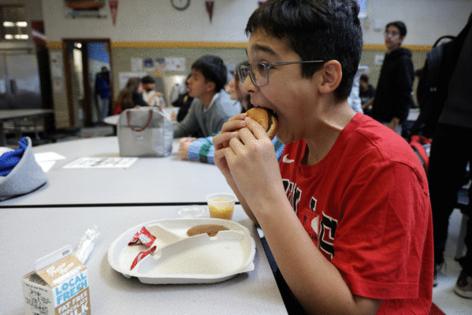Editorial: Who's afraid of a healthy school lunch?
Published in Op Eds
In Japan, most schools serve freshly prepared, nutritionally balanced lunches — often rice, fish or meat, soup and vegetables. French cafeterias typically offer multi-course meals that might include salad, a main dish, bread, cheese and dessert.
By contrast, many Americans recall their own school lunches as far less appealing.
Some of us remember rectangular pizza with cheese the consistency of plastic, topped with tiny cubes of what was described as “pepperoni.” Wilted lettuce doused in watery dressing passed off as salads. Mashed potatoes out of a box and mystery meatloaf. It’s hard to imagine there was much nutritional value in any of the food we were fed.
So why not make it better?
Secretary of Health and Human Services Robert F. Kennedy Jr. has launched an initiative to improve the nutritional quality of school lunches — a move that, despite his controversial reputation on other issues, deserves serious consideration.
It’s not as if this is a partisan notion, and people of all political persuasions have taken on the cause of championing better nutrition for school kids, which certainly encourages better cognitive function and makes it easier for kids to check in — rather than out — of the classroom during the school day.
Over a decade ago, Chicago Public Schools kicked off its Farm to School initiative, incorporating produce and other products from local farms into the district’s lunch program.
“The program influences food purchasing to allow students to gain access to healthy, local foods,” according to the district website.
Around the same time, New York City piloted a “Fruit and Vegetable Prescription Program” that let doctors give low-income patients vouchers for fresh produce — including pediatric patients — recognizing the role of diet in health and the barriers many families face in affording healthy food.
These trends of the 2010s are also absolutely in keeping with the spirit of the current conversation about what kids should be eating in schools.
The HHS secretary initially announced his school lunch initiative in the spring, but now with school starting across much of the country, administrators are grappling with what updated guidelines would mean for their meal programs and their bottom lines.
His plan calls for removing processed foods and synthetic dyes from school meals, citing evidence that about 70% of the food served in these programs is ultra-processed. Research shows the stakes are high. In 2023, children were 15% to 20% more likely to have a chronic condition than in 2011, according to research published in the Journal of the American Medical Association. And 1 in 5 young people in the U.S. are obese, according to the Centers for Disease Control.
This isn’t about fat or skinny, this is about being healthy. And these numbers are alarming, which makes action worthwhile.
Of course, idealism always hits a brick wall when it runs up against the harsh reality of budget constraints and sourcing difficulties. Moving to a school meal model centered on whole, locally sourced foods would likely demand major new investments in food, infrastructure and staffing. Securing that funding could be challenging.
Yes, it will cost money, but a chronically unhealthy U.S. population is costly too.
Past reforms — from eliminating trans fats to adding more fresh produce — once seemed impossible too. The payoff in healthier kids, sharper minds and fewer long-term health costs is worth the investment.
_____
©2025 Chicago Tribune. Visit chicagotribune.com. Distributed by Tribune Content Agency, LLC.
























































Comments